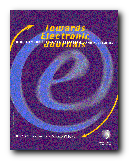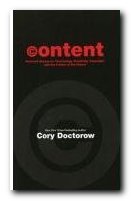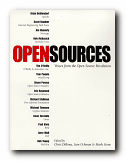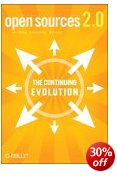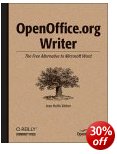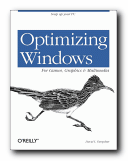online language-learning activities using Moodle
I have been critical of some of these Moodle guides in the past. That’s because most of them are not much more than an explanation of Moodle’s individual features, but no suggestions about how they might be used to create dynamic eLearning courses, exploiting the interactivity that Moodle offers. Moodle for Language Teaching is far more useful, because it approaches these issues the other way round. It starts with the premise of online learning design, then shows how it can be done using Moodle.
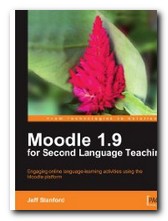 Jeff Stanford very sensibly begins by explaining the structure of a course in Moodle, and how its parts relate to each other. It’s important if you haven’t used Moodle before to understand the difference between course content and the extras that can be attached via blocks and add-on modules. [You also need to get used to the names of all these features.] All this will help you to conceptualise your course design, and it explains clever supplements such as Mobile Quiz which allows the downloading of quiz questions onto mobile phones.
Jeff Stanford very sensibly begins by explaining the structure of a course in Moodle, and how its parts relate to each other. It’s important if you haven’t used Moodle before to understand the difference between course content and the extras that can be attached via blocks and add-on modules. [You also need to get used to the names of all these features.] All this will help you to conceptualise your course design, and it explains clever supplements such as Mobile Quiz which allows the downloading of quiz questions onto mobile phones.
Stanford also explains how to choose all the important settings for a course – the various permissions, users, course timetable, and what will be shown to students in the way of grades, results, and feedback. All of these options are amazingly detailed and customisable from within Moodle – so long as you know your way around the various settings.
All of his explanations are offered in a direct ‘Here’s how to do it’ manner, with screenshots showing you what to expect and copious lists of free software to help you achieve what you’re looking for. But be warned! Take anything new one step at a time, and don’t expect to create a richly interactive multimedia course in just a few days. Or – if you are new to Moodle – even a few weeks.
He explains how to create quizzes – and here’s an extra tip from someone who did this the hard way. You should learn how to categorise and store your quiz questions groups, so that you can re-use them in different combinations. This will save you the laborious effort of re-keying questions and their multiple possible answers.
The book understandably uses language learning as its pedagogic objective, but in fact almost all of the features of Moodle discussed could be used for creating courses in other subjects. For instance the glossary building activity to create lists of key terms and a ‘word a day’ feature; the Chat module, which acts in the same way as other Instant Messaging systems; or the ‘Hot Potatoes’ quiz-making module.
It’s assumed that the second language being taught is English, so this makes both the ideas and the examples useful for teachers of English, communication skills, or other language-oriented courses.
Many of the stages of course creation involve entering small items of information into a data base using forms. There is quite a conceptual gap between the data entry process and what appears on screen as the final result to a user. You should expect to find this quite arduous at first, but then straightforward once you’ve done it a few times.
There are lots of different types of quizzes possible – missing words, multiple choice questions, matching words, or matching pictures to text – and you can also shuffle questions so that no two people see them in the same order (which I can assure you helps to minimize copying by students using adjacent screens).
For a language course he naturally explains the use of audio and video files to enhance learning. There’s a free add-on module called NanoGong which can be used in conjunction with a quiz to produce vocabulary, pronunciation, intonation, and word stress exercises. You can also make short podcasts or add dictation exercises to which students reply in writing.
There are any number of opportunities to allow students to interact with each other, compare notes, see each other’s blog entries, rate discussion contributions, swap messages via email and the forum, and comment on each other’s work. But here’s another tip from hard won experience. Before you design a course, make sure how much time the tutor (even if that is you) can spend monitoring all this activity and participation in group work. Many institutions see online learning as a way of saving the expense of tutor time, rather than enhancing the student’s learning experience.
Writing activities are relatively straightforward. Students enter text and save their efforts as a journal, a blog, their profile, or as an assignment. You’ll be lucky if they do just one of these. But they do like feedback on any work submitted – so the book quite rightly ends with a section explaining the huge variety of assessment and grading systems that are available in Moodle.
In fact there is so much guidance and support available that it won’t all fit in this (fairly long) book. So two additional chapters have been placed on the publisher’s web site. These cover making your Moodle course materials look nice on screen, and preparing your students to use Moodle.
I’ve a feeling that the publishers Packt have learned from feedback on their earlier Moodle guides, and have wisely gone down the road of putting the designer’s needs first. Their formula works well here, and this guide for me is a better manual for designing courses than all the others currently available. We’ve been designing customized Moodle courses at www.texman.net for the last few years now, and having a guide like this at the outset would have flattened what at times was a painfully steep learning curve.
© Roy Johnson 2009
Jeff Stanford, Moodle 1.9 for Second Language Teaching, Birmingham: Packt, 2009, pp.505, ISBN: 1847196241
More on online learning
More on technology
More on digital media
More on web design
More on computers



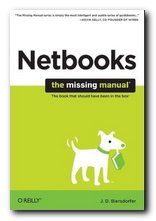
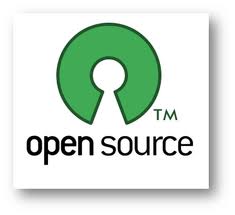 It is now not uncommon to hear of staff packing any remaining teaching commitments into one term (or semester) – giving them two-thirds of a year free to do as they wish. At professorial level it’s even worse. At my former university a well-known academic with an international reputation on a six-figure salary taught for two hours once a fortnight, refused to make his email address or his telephone number available to anyone, and lived outside the UK, jetting in for his celebrity seminars every two weeks and returning home the same day.
It is now not uncommon to hear of staff packing any remaining teaching commitments into one term (or semester) – giving them two-thirds of a year free to do as they wish. At professorial level it’s even worse. At my former university a well-known academic with an international reputation on a six-figure salary taught for two hours once a fortnight, refused to make his email address or his telephone number available to anyone, and lived outside the UK, jetting in for his celebrity seminars every two weeks and returning home the same day.